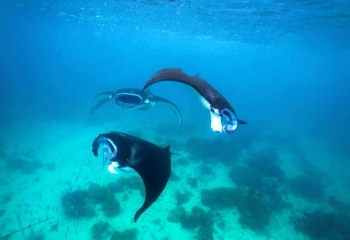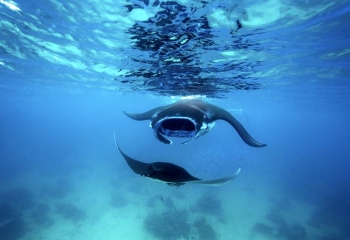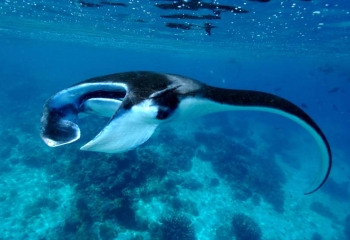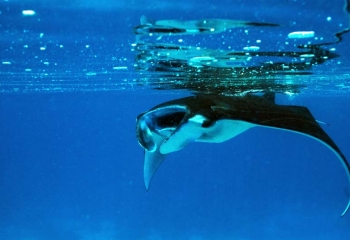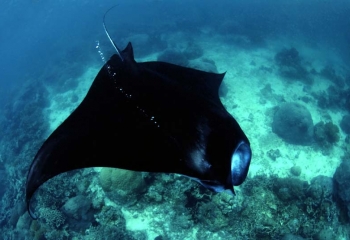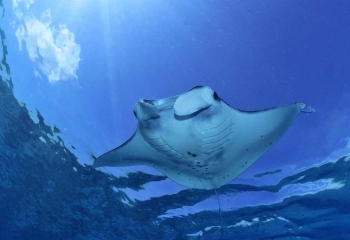Sangalaki
Manta Point
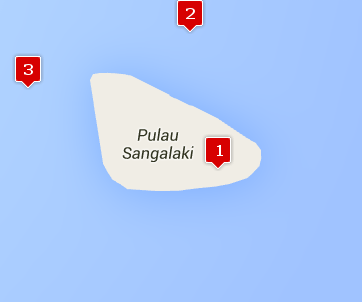
Sangalaki Island: (VIP Hunt: Manta Ray)
Dive Sites (labelled on map above):
- Cleaning Station
- Manta Parade
- Manta Run
Perhaps this in the most excited point among all. The only thing when you dive at this point, you have to go when there in a high-tide. Otherwise, you ‘can only spot a few mantas under water. But on a high-tide, you can just loose count of the mantas on the surface, not to mention when you dive underwater from 5 meters to 15 meters. Visibility: 20 to 25metres. Current: Mild.
Sanglaki is located about 120 miles of Tawau and 90 miles south-east of Tarakan, Indonesia which is approximately 2 degree above the Equator. This densely forested white sandy beaches island can be circumscribed in less than 30 minutes, the reefs extend out to about 600 meters from shore and tropical bushes around provide ideal hideouts for turtles to lay eggs. Currently about 11 dive sites has been identified with depth ranges from 10 feet (3m) to 80 feet (24m). Catch the moment of the life time wawtching turtles crawl on shore to nest each night, Manta Rays, Squid and Cuttle Fish, Giant Clam, Grouper, Lobsters, Stingrays, Sharks, huge corel fans, Tube Sponges and etc. All diving are boat dives and mostly drift diving.
The Island of Sangalaki is located off the East coast of the Indonesian portion of Borneo.
The Sangalaki Dive Lodge resort is uncrowded, the diving is spectacular, and exotic marine life that you've probably only seen in National Geographic is plentiful. You'll see Cuttlefish, Blue Ribbon Eels, Frogfish, Turtles, Manta Rays, Sharks, DOZENS of Species of Nudibranchs, HUNDREDS of species of hard and soft corals schools of brightly colored Fusaliers and ZILLIONS of colorful reef fishes.
The Island of Sangalaki and its’ surrounding reefs are protected as an Indonesian Marine Park. Without the destructive effects of explosives and cyanide fishing, Sangalaki has remained a pristine example of an untouched tropical marine ecosystem. In a world where every resort claims to be situated in a "diver’s paradise", Sangalaki truly deserves the honor.
Unlike other Island resorts in the area, Sangalaki has its emphasis on Conservation & Ecology; less that 3% of the Island is built upon, leaving the Tropical Rainforest to its’ natural inhabitants and visiting guests.
Sangalaki is the prime nesting site for Green Sea Turtles in South East Asia.
Sangalaki is surrounded by a shallow lagoon and the reefs start a distance out from the Island. Since there is so much shallow reef here, there is a vast diversity of marine life, and since the area is a protected marine park, the reefs are quite pristine. Most Dive sites are shallower than 65 feet (20 M.) The reef slope gently and all dive sites have excellent shallow areas for the end of your dive. The hard and soft corals at Sangalaki are amazingly prolific with over 500 species present around the island (compared to only 67 species in the ENTIRE Caribbean). Fish life and invertebrates are also prolific. Sangalaki is a good place to see both large and small marine creatures. When you look up after watching a colorful Nudibranch, don't be surprised to see a Turtle or Manta Ray swimming by.
The majestic Manta rays have been aptly compared to stealth bombers. This is especially true of the glistening all black ones which can be seen here at Sangalaki Island. They usually swim in the upper waters, somersaulting and gambolling, their massive wings breaking the water as they soar into the air and come crashing loudly down into the water so snorkelling or free diving is a wonderful way to observe them, and they will often come over to greet you. These amazing creatures are strong, swift swimmers and may even cross the open ocean, their sandpaper skin and wide wingspan attract Remora and other parasites, which they remove regularly at reef-side ‘cleaning stations’ as well as by their crashing dives. They live off the plankton which they filter through the many rows of teeth on their lower jaw. These are so plentiful around Sanaglaki that the Mantas rarely have to seek in deeper waters for food, which is probably why they can be found here in large numbers throughout the year.
Giant Green Turtles nest on the sandy beach all year round and you can see them in all sizes swimming under ledges and in the gullies throughout the reef. The rare Hawkbill turtle can also be found here and there have been occasional sightings of the Leatherback Turtle as well.
There are over 500 varieties of soft and hard coral in the reefs surrounding the island (the entire Caribbean has only 67) and the invertebrate and fish life of all sizes is just as prolific, so you ned not fear running out of things to see. The reef is riddled with small ridges and gullies which form individual mini ecosystems, each with its own population of exotic fish and coral including stingrays, cuttlefish, batfish, barracuda, triggerfish, angel fish, and a variety of grouper.
Destination
Remember to bring
Water activities
Part of the Marine Heritage Park, Sangalaki Island is one of the richest diving grounds in Indonesia,
Sangalaki is part of Indonesia and you will need to fulfil that country's entry visa requirements. Please note the border crossing from Tawau in Malaysian Borneo is not one which currently issues visas on arrival so please ensure that you obtain a visa prior to your trip.
A day-trip to snorkel in the freshwater lake teeming with non-stinging jellyfish is another experience which will stay with you forever.
http://www.dive-the-world.com/diving-sites-indonesia-sangalaki-island.php
Manta Point
The manta rays are found in huge numbers at the dive sites found on the east coast, namely Manta Avenue, Manta Parade and Manta Run. Usually, you'll find these graceful creatures near the surface with their gills wide open as they feed on the rich plankton to be found in these waters. The mantas can also be found cruising the seas or less often foraging for sustenance down on the sea beds. They may not be huge oceanic manta rays but you will have no complaints if you find yourself in the middle of 6 or 7 mantas swooping all around you.
No permit fee
Lighthouse Reef - is a site located on the eastern part of Sangalaki Island. Your dive boat will be moored at the lighthouse which gives this reef its name, and this is where your dive will begin.
Within this site there are 2 small wrecks. The older one is identified by the proliferation of more soft corals of the dendronephthya species and magnificent sea anemones, where you'll find sweetlips, gobies, scorpionfish, anemonefish and clownfish, jawfish,ribbon eels and groupers lurking furtively under the wreck.
Among the gorgonian fans, keen eyesight will allow you to spot pygmy seahorses. While on the sandy bottom watch out for tridacna giant clams dotted around, always a pleasure to find.
Lighthouse Reef - is a site located on the eastern part of Sangalaki Island. Your dive boat will be moored at the lighthouse which gives this reef its name, and this is where your dive will begin.
Within this site there are 2 small wrecks. The older one is identified by the proliferation of more soft corals of the dendronephthya species and magnificent sea anemones, where you'll find sweetlips, gobies, scorpionfish, anemonefish and clownfish, jawfish,ribbon eels and groupers lurking furtively under the wreck.
Among the gorgonian fans, keen eyesight will allow you to spot pygmy seahorses. While on the sandy bottom watch out for tridacna giant clams dotted around, always a pleasure to find. Show less
Manta Parade - As the name of this dive spot indicates, majestic manta rays parade up and down this manta highway, coming to you from all directions. More often than not, you'll find them just breaking the surface as they feed on the rich plankton to be found in these waters. For that reason, snorkelling at this site is just as good as diving at it.
Located at the north of Sangalaki Island, Manta Parade is actually one of the 3 dive sites which form manta highway land. If the mantas are not feeding in the waters, they're usually being preened by cleaner wrasse at cleaning stations.
The sight of the manta rays is awe inspiring. They glide and swoop by you; the friendlier and more inquisitive will come right up to you. Watching their sleek movements underwater, one is reminded of fighter jets in the skies - in fact, black manta rays look just like a stealth bombers (if you use your imagination!).
The topography of this Sangalaki scuba diving site starts with Manta Avenue which is a set of coral steps where, besides mantas, you'll find elegant fire gobies and dancing gobies. It then continues onto Manta Parade where the reef is a set of ridges which rise up and down like little underwater hills. Here small coral heads, gorgonian fans and large barrel sponges lie on a flat sandy bottom, littered with alabaster sea cucumbers and feather stars. Within them, you'll find sea anemones with clownfish, flat worms, fan worms, sea stars, cushion stars and reef fish like frogfish, crocodilefish, parrotfish, angelfish, triggerfish, snappers, fusiliers, sweetlips, lionfish, scorpionfish and stonefish.
When you start seeing rocky coral outcrops and bommies, you're at Manta Run. Here, you'll find more gorgonian fans, soft corals and barrel sponges, all topped off with feather stars. Within the numerous crevices and overhangs, there are leaf fish and frog fish which, if you happen to stumble upon them during feeding times, you'll witness preying on the somewhat gullible cardinalfish. Show less
Turtle Town - Green turtles are the main attraction at this Sangalaki diving site, as implied by its name. You'll either find them feeding, mating or resting. When you bare in mind that an annual average of 20 - 30 turtle nests are laid on the beaches each night, you'll have a better idea of the size of the mating activities of the turtles.
Turtle Town is the more famous of the 2 sites in Sangalaki where you will come across its famous green turtles. Located in the southwest corner of Sangalaki, there are gullies and stony ridges all over the place at this rather flat dive site, which make this place ideal for green turtles to stop for a bite to eat or rest up for a while.
Along with them, you'll also find reef fish like pufferfish, moorish idols as well as sea stars and feather stars. Other marine life which you'll see here include octopus, giant cuttlefish, popcorn crabs, catfish, shy mandarinfish and for lovers of macrolife,flamboyantly coloured nudibranchs
Manta Point (Sangalaki)
Perhaps this in the most excited point among all. The only thing when you dive at this point, you have to go when there in a high-tide. Otherwise, you ‘can only spot a few mantas under water. But on a high-tide, you can just loose count of the mantas on the surface, not to mention when you dive underwater from 5 meters to 15 meters. Visibility: 20 to 25metres. Current: Mild.
Sangalaki Island: (VIP Hunt: Manta Ray)
Dive Sites:
- Cleaning Station
- Manta Parade
- Manta Run
